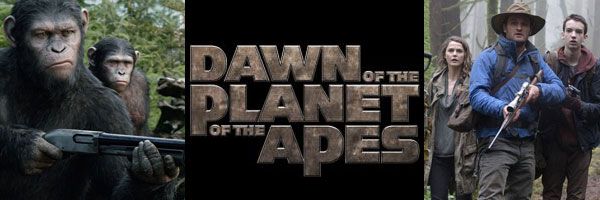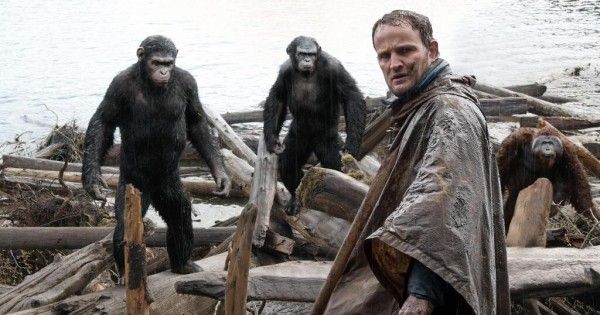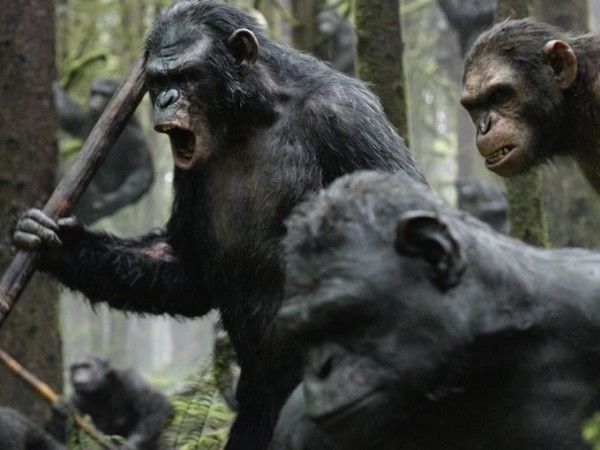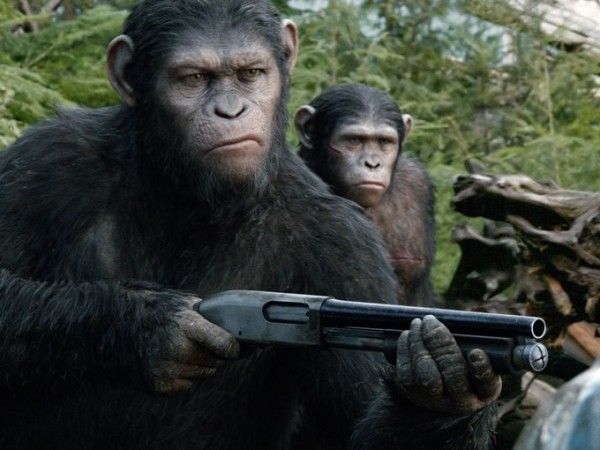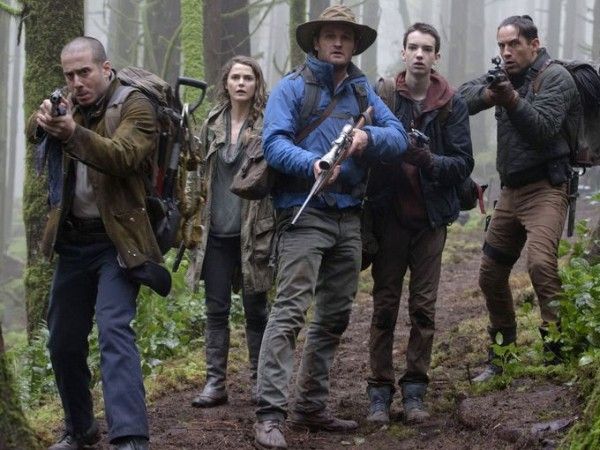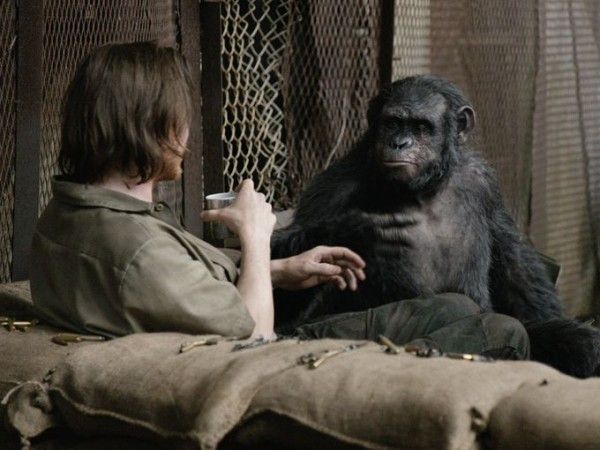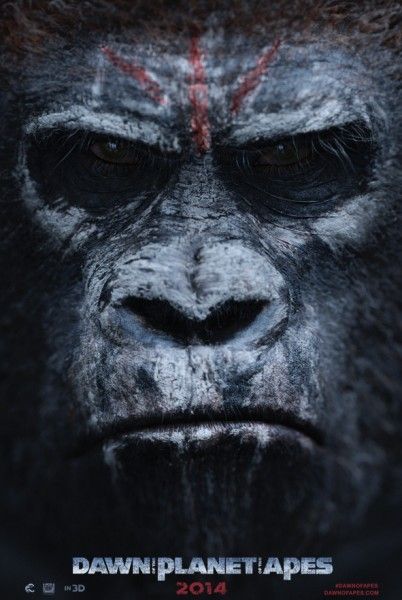Rise of the Planet of the Apes was a great movie. In a summer filled with explosions and spectacle, Apes used motion capture and other modern technology to help tell its story and audiences embraced the film. By the time the movie finished it's theatrical run, it had made close to $500 million worldwide. Based on the box office and reviews, it was no surprise when Fox moved forward with the sequel, Dawn of the Planet of the Apes. The 2011 film set up a world and story that people wanted to see more of, so this felt like a sequel that was being made for the right reasons.
Last summer, when director Matt Reeves was filming in New Orleans, I got to visit the set with a few other online reporters. While on set I watched some filming, participated in group interviews with some of the cast and filmmakers, and learned a lot of cool stuff about one of my most anticipated films of 2014. If you're looking forward to Dawn of the Planet of the Apes, hit the jump for 45 things to know about the film.
Before getting to the list, if you haven't seen the Dawn of the Planet of the Apes trailer, I'd watch that first:
-
Here's 45 things to know about Dawn of the Planet of the Apes:
- The film picks up ten years after Rise of the Planet of the Apes. The Simian virus has wiped out 90% of the human population. The remaining human population struggles for life in the city, while the colony of apes thrive in Muir Woods.
- Producer Dylan Clark says that this film is the story of both the apes and the humans, with a pretty even split between the two storylines. He credits director Matt Reeves with bringing more focus to the ape community as the original script was slanted toward the humans in the city.
- Clark also says that Reeves was able to bring an outsider’s point of view to the project and remind them of what they had done successfully on the first film.
- According to Clark, James Franco and Frieda Pinto's characters, Will and Caroline, were never meant to survive the first film, saying that they were ground zero for the virus. Further, as the Frankenstein character Will needed to be punished for his culpability in the near extinction of the human race.
- The original script for Rise of the Planet of the Apes showed Will dying, and while the scene was shot, Clark described it as a bad day of shooting, saying it was too "hokey" and "lame" to fit in the final film.
-
Serkis describes Caesar as an "egalitarian" king, ruling a community of about 2,000 apes. He describes him as an "Ape's ape", and while Caesar was effectively raised as a human he has spent the last ten years getting in touch with his inner-ape.
- The ape community has evolved over the course of ten years to have rules, codes of conduct, ethics and language.
- The language of the apes is only semi-evolved, using sign language and gesturing, as well as grunts and some speaking. It is a midway point between what we saw in Rise and the fluently speaking apes we're know from the original Planet of the Apes.
- Serkis says the film will also explore the power of language and those who can speak as a new generation of apes comes into play. He says it is like how children now pick up computer skills rapidly, so do the younger apes pick up language.
- Caesar has a partner, Cornelia, played by Judy Greer. Together they have a son River, who is about 15 years old in human years, and a newborn baby. The film will deal with the father/son relationship as River learns to take responsibility, develop his own beliefs and grow in to a leader in his own right.
- Conflict arises between the humans and apes when a group of humans, led by Jason Clarke's character Malcolm, venture into ape territory in search of a dam. The humans are suffering in the city and in desperate need of power.
- While Caesar sympathizes with the humans and does not want them to go extinct, he struggles with a decision to help them, recognizing that they are suffering because of their own hubris and needing to protect his colony and his family first.
- Producer Dylan Clark points out that while Caesar was raised and loved by humans, many of the other apes do not have good experiences with humanity and are far less sympathetic to their plight. There will be dissent within the ape community, as those apes who are unsympathetic to the human suffering disagree with Caesar's compassion.
-
A scene in the film's first act will show Caesar and the apes venturing into the human territory to make a demonstration of strength and clarify that if the humans violate their space they are willing to go to war.
- Clark says Caesar and Malcolm have an adversarial relationship that grows into friendship. Serkis says they share a "bond of mutual respect".
- Serkis describes the film as a Godfather movie wherein Caesar is Don Corleone "coping with all the machinations of a politically difficult early foray into creating a regime."
- Clark says they are not overly concerned with providing a big twist at the end, citing that as one of the major failings of the Tim Burton film.
- He also says there is not likely to be any overt references to the original franchise a la "Take your stinking paws off me you damn dirty ape." Saying that the line didn't fit, didn't go over well with fans, and was placed in the film due to pressure from higher ups in the studio.
- Serkis credits the film as the most ambitious performance capture film to date because most of the film is shot on location rather than on a soundstage . He also calls it the most challenging performance he's had to give due to the fact that Caesar is now really straddling the line between human and ape, a very tricky middle ground.
- The two sets that take place on a soundstage are inside the dam and Caesar's dwelling in the ape village.
- While there are a number of actors playing apes in the film, according to Serkis, the bulk of the 2,000 or background apes in the community are played by himself and Terry Notary.
- Compared to the first film, Clark says Dawn is "Slightly edgier, slightly darker, a little bit cooler...more realistic and grounded."
-
Count on this film having a significantly higher number of visual effects shots. Where Rise only had one ape in the first half of the film, Dawn is dealing with an entire community of apes from the get-go.
- Clark says that the visual effects team had difficulty with the apes' legs and lips in the first film and that these troubles have been resolved. Further, they have a new stunt team capable of 25% more than what they could do in the first film.
- Matt Reeves wanted to draw parallels to Pocahontas and the Aborigines in Australia, where white men come into a foreign land.
- Clarke talked to friends of his before signing on, including Kathryn Bigelow, and they all said if Matt Reeves was involved then he had to do it.
- Toby Kebbell plays Koba, a character who appeared in the first film and is a trusted advisor to Caeser. Koba was operated on 400-500 times and has lost an eye in a lab experiment.
- For his performance capture suit, Kebbell used “Cross Gloves” which allowed him both dexterity and the ability to quad on his fist.
- There is a generational difference between the apes who grew up in the medical labs and those that were raised in the wild, with Koba being especially prejudiced towards humans.
- After the principal photography, the ape actors did a month of shooting on a motion-capture stage to perform the more stunt-intensive work that couldn’t practically be done on location. The “volume” shooting was also done to capture more detail for the ape performances.
-
During the first week of shooting, Kebbell had trouble getting his hips down to where they needed to be and didn’t think he could do it, but with help from Andy Serkis and motion teacher Terry Notary, he got there.
- Nick Thurston, who plays River, Caesar’s 15-year-old son, says the ape community is very insulated, and they drew inspiration from early Native American tribes.
- There’s a rebellious nature to River, and he has an additional role model in Koba, who has a sever hatred for humans unlike Caesar.
- The ape actors attended “Ape Camp” for two and a half weeks before filming began.
- Cinematographer Michael Seresin used Arri Alexas to shoot the film in native 3D, because he felt it was the closest to film.
- Shooting days are around 30% longer when filming in 3D.
- They went for a subtle 3D look for the film.
- The biggest challenge for Seresin was to make the film look like San Francisco when they were shooting in New Orleans with Louisiana light.
- The actors had to ride the horses like apes would, so they were in high stirrups like jockeys instead of wrapping their legs around the horses.
- They have a liberty-trained horse for some of the more elaborate stunts.
- Terry Notary says the point of “Ape School” was to help the actors learn how to find the apes inside themselves, instead of trying to imitate an ape.
- The key to performing as an ape was learning to be still, instead of our modern natural tendency to always be moving and doing something. It’s about stillness, says Notary, and going back to being simple and aware.
-
As the apes are evolving, they allow the humanness to come seep the performances.
- The ape performance capture suits are sturdier this time around, and are also waterproof. On the first film, they were delicate and would need repairing after every take.
- There are bigger battles and action in Dawn than the first film, and it marks the first step towards the original Planet of the Apes post-human world.
Dawn of the Planet of the Apes opens July 11. For more from my set visit:

